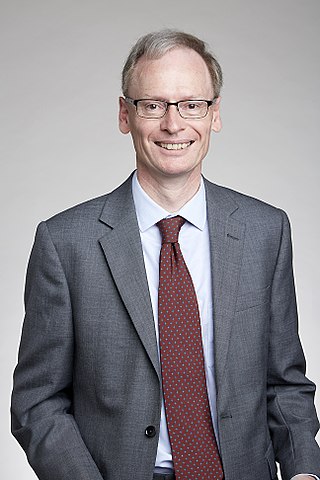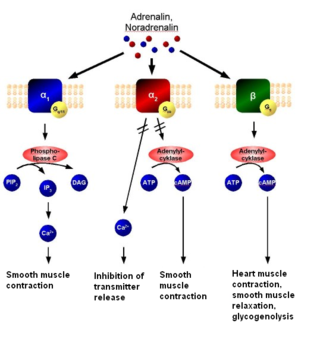
The pulmonary circulation is a division of the circulatory system in all vertebrates. The circuit begins with deoxygenated blood returned from the body to the right atrium of the heart where it is pumped out from the right ventricle to the lungs. In the lungs the blood is oxygenated and returned to the left atrium to complete the circuit.
Stephen E. Epstein is the Head of Translational and Vascular Biology Research at the MedStar Heart and Vascular Institute, MedStar Washington Hospital Center and Clinical Professor of Medicine at the Georgetown University School of Medicine.
Tomasz Jan Guzik is a Polish physician scientist. Since 2012, he has been the Regius Professor of Physiology at the University of Glasgow.
Years of potential life lost (YPLL) or potential years of life lost (PYLL) is an estimate of the average years a person would have lived if they had not died prematurely. It is, therefore, a measure of premature mortality. As an alternative to death rates, it is a method that gives more weight to deaths that occur among younger people. An alternative is to consider the effects of both disability and premature death using disability adjusted life years.
The Bowditch effect, also known as the Treppe phenomenon or Treppe effect or Staircase Phenomenon, is an autoregulation method by which myocardial tension increases with an increase in heart rate. It was first observed by Henry Pickering Bowditch in 1871.

Atrial Light Chain-2 (ALC-2) also known as Myosin regulatory light chain 2, atrial isoform (MLC2a) is a protein that in humans is encoded by the MYL7 gene. ALC-2 expression is restricted to cardiac muscle atria in healthy individuals, where it functions to modulate cardiac development and contractility. In human diseases, including hypertrophic cardiomyopathy, dilated cardiomyopathy, ischemic cardiomyopathy and others, ALC-2 expression is altered.

Valentín Fuster Carulla, 1st Marquess of Fuster is a Spanish cardiologist and aristocrat.
EP Europace is a peer-reviewed medical journal published by Oxford University Press that publishes research articles about the study and management of cardiac arrhythmias, cardiac pacing, and cardiac cellular electrophysiology. It is 1 of 13 official journals of the European Society of Cardiology and is the official journal of the society's working groups on Cardiac Cellular Electrophysiology and e-Cardiology and of the European Heart Rhythm Association.
John Eric Deanfield is a British professor of cardiology and past Olympic fencer.
Survivor Activating Factor Enhancement (SAFE) is a metabolic pathway. It is an intrinsic protective signaling program to limit cell death activated by the heart. This pathway allows ischaemic postconditioning that helps protect against reperfusion injury. This path involves the activation of a transcription factor called signal transducer and activator of transcription 3 (STAT3). The SAFE pathway interacts with the reperfusion injury salvage kinase pathway to convey the ischemic postconditioning stimulus from the cell surface to the mitochondria, where many of the prosurvival and death signals appear to converge.

Hugh Christian Watkins is a British cardiologist. He is a Fellow of Merton College, Oxford, an associate editor of Circulation Research, and was Field Marshal Alexander Professor of Cardiovascular Medicine in the University of Oxford between 1996 and 2013.
Peter Sleight was a British research cardiologist and an Honorary Consultant Physician at the John Radcliffe Hospital in Oxford and the Oxford University Hospitals NHS Foundation Trust. Sleight was Emeritus Field Marshal Alexander Professor of Cardiovascular Medicine at the University of Oxford and an Emeritus Fellow of Exeter College, Oxford.

Adrenergic receptor autoantibodies
Thomas F. Lüscher is a Swiss professor of cardiology, director of research, education and development and a consultant cardiologist at the Royal Brompton and Harefield NHS Foundation Trust and Imperial College London, and director of the Center for Molecular Cardiology at the University of Zurich.
Gemma Alexandra Figtree is an Interventional Cardiologist at Royal North Shore Hospital, Professor in Medicine at the University of Sydney, chair of the Federal Government's 10-year Mission for Cardiovascular Health, and co-leader of the Cardiovascular Theme for Sydney Health Partners.
Esther Lutgens is a Dutch physician and molecular biologist who is Professor of Vascular Immunopathology at Amsterdam University Medical Centre. She studies the modulation of co-stimulatory pathways and the immune system.

Roberto Ferrari is an Italian cardiologist who holds the position of Emeritus Professor at the University of Ferrara, where besides he was the chair of the Cardiology in the School of Medicine until the 2019–2020 academic year.

Peter Kohl is a German scientist specializing in integrative cardiac research. He studies heterocellular electrophysiological interactions in cardiac tissue, myocardial structure-function relationships using 'wet' and 'dry' lab models, and mechano-electrical autoregulation of the heart.

Ali J. (AJ) Marian is an American physician-scientist in the fields of cardiovascular medicine and genetics. He is a professor of molecular medicine (Genetics), professor of medicine (Cardiology), and director of the Center for Cardiovascular Genetic Research at the Brown Foundation Institute of Molecular Medicine at the University of Texas Health Science Center, Houston, Texas. He also holds the James T. Willerson Distinguished Chair in Cardiovascular Research and is most known for his works on the molecular genetics, genomics, and biology of cardiomyopathies.
Lionel Henry Opie was a South African cardiologist. He was a professor of medicine at the University of Cape Town, where he conducted both experimental and clinical research on heart disease and cardiovascular physiology, metabolism, and pharmacology. He was the founding director of the university's Hatter Institute for Cardiovascular Research and the founding editor of the Journal of Molecular and Cellular Cardiology. He also served as president of the International Society for Heart Research.








